Home Remedies For Sciatica: 10 Natural Relief Tips
Simple yet effective natural methods to ease pain in your lower extremity.

Image: shutterstock

Sciatica is a type of pain that occurs when the sciatic nerve is irritated. Home remedies for sciatica can help alleviate the discomfort that usually starts in the lower back and spreads to the legs.
Sciatica pain can be incapacitating and agonizing, throwing your life into disarray. To assist you in managing sciatica symptoms, we’ve put together a list of basic home treatments in this post. Continue reading to learn more.
In This Article
What Triggers Sciatica?
Sciatic pain is associated with the nervous system. It is the result of excess pressure on the lumbar disc. Other contributing factors include inflammation or irritation of the sciatic nerve by an adjacent bone. Some underlying issues also cause sciatica. These include:
- Malignant growth
- Degeneration of the spine due to lack of vitamin D
- Bad posture or stress injury that causes disc hernia
- Inflammation that results in internal bleeding
- Spine-related infections
- Pregnancy
According to the Centers for Disease Control and Prevention (CDC), 39% of adults had back pain, 36.5% had lower limb pain, and 30.7% had upper limb pain in the last 3 months of 2019. It was further observed that women (40.6%) were more likely to experience back pain than men (37.2%).
These are a few factors that trigger sciatica. The following are the risk factors that may increase the likelihood of developing sciatica:
- Smoking
- Obesity
- Genetics
- Vitamin B12 deficiency
- Leading a sedentary, inactive lifestyle
- Poor work ergonomics
- Depression
- Certain occupations (carpenters, truck drivers, and machine operators)
It is important to note that the mere presence of these risk factors does not indicate that you will develop sciatica. The individual’s age and health also have a role to play in this aspect.
 Quick Tip
Quick TipWe will now explore natural remedies that can help manage the symptoms of sciatica.
Key Takeaways
- Sciatica is a type of pain that occurs when there’s excess pressure on the lumbar disc, irritation or inflammation of the sciatic nerve.
- Hot and cold compresses may help lower the inflammation and discomfort related to sciatica.
- You can massage the target area with essential oils like peppermint or ginger oil to help decrease muscle tension and get relief from the pain.
- Garlic milk, turmeric, celery juice, valerian root, fenugreek seeds, aloe vera may also help alleviate the pain.
- Walking at regular intervals, doing a light workout or stretching exercises, and maintaining the correct posture may help you get relief from the constant pain.
Home Remedies To Provide Relief From Sciatica
- Garlic Milk
- Hot Or Cold Compress
- Ginger Essential Oil
- Peppermint Oil
- Turmeric
- Vitamins
- Celery Juice
- Valerian Root
- Fenugreek Seeds
- Aloe Vera
1. Garlic Milk
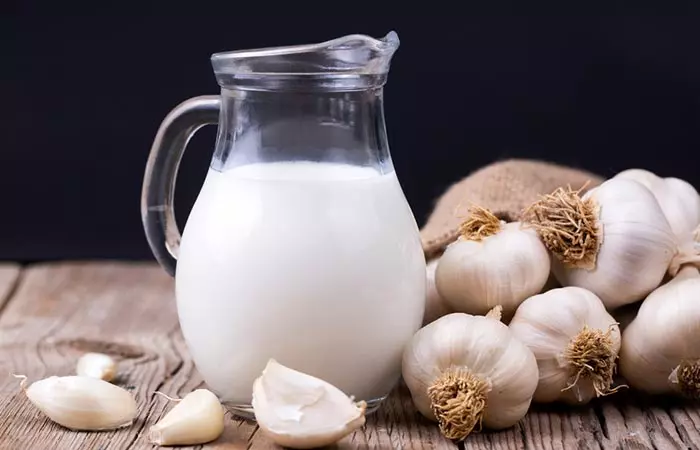
Garlic has anti-inflammatory properties (1), (2). Hence, it may help in reducing the inflammation and pain associated with sciatica.
You Will Need
- 8-10 cloves of garlic
- 300 mL of milk
- 1 cup of water
What You Have To Do
- Crush the garlic cloves.
- Add milk, water, and the crushed garlic to a saucepan. Bring the mixture to a boil.
- Let it simmer. Allow it to cool down for a while.
- Consume the mixture while it is warm. You can add a few drops of honey for taste.
How Often You Should Do This
Consume this 2 times a day.
2. Hot Or Cold Compress
Hot and cold therapy may help reduce the inflammation and pain related to sciatica to a great extent (3), (4).
You Will Need
- A washcloth
- A bowl of ice-cold water or ice cubes
- Warm water
What You Have To Do
- Dip a clean washcloth in warm or cold water, depending on whether you are using a hot or a cold compress.
- Wring out the excess water and place it on the area where you experience acute pain.
- Repeat this process every 5-6 minutes.
How Often You Should Do This
Do this 3-4 times a day.
3. Ginger Essential Oil
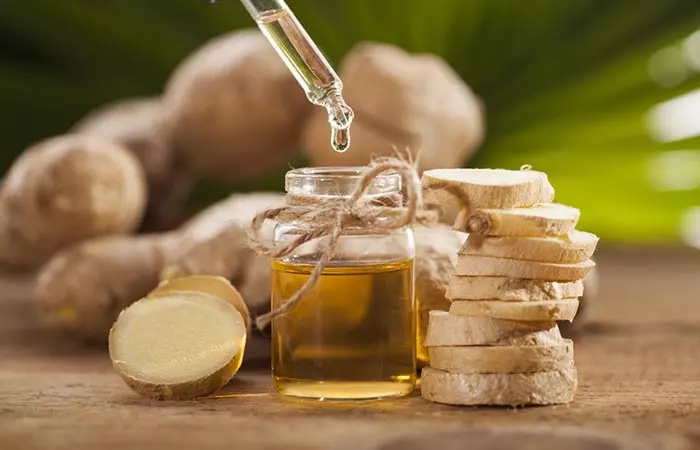
Ginger essential oil may have a soothing effect on lower back pain (5). It contains [6]-gingerol, which exhibits analgesic and anti-inflammatory properties (6). These properties may help reduce pain.
You Will Need
- A few drops of ginger essential oil
- Carrier oil of your choice
What You Have To Do
- Dilute the ginger essential oil with a carrier oil like olive oil.
- Apply this blend to your lower back.
How Often You Should Do This
You can do this 2 times a day for relief.
4. Peppermint Oil
Peppermint has analgesic and anti-inflammatory properties (7), (8). Its ability to relieve pain might help in providing relief from sciatica. Moreover, if you are searching for a home remedy to get rid of backache, peppermint oil might be a great option due to its soothing properties.
You Will Need
- 5-6 drops of peppermint oil
- Carrier oil
What You Have To Do
- Dilute peppermint oil with a carrier oil like sweet almond oil.
- Apply this mixture to the affected area.
How Often You Should Do This
You can do this 2 times a day.
5. Turmeric
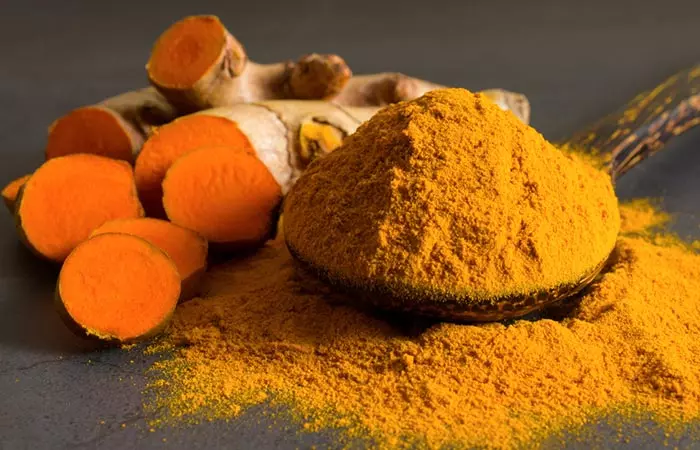
Turmeric contains a bioactive compound called curcumin that possesses analgesic and anti-inflammatory properties (9). It can also accelerate nerve regeneration (10). These properties of turmeric may help in reducing sciatic nerve pain.
You Will Need
- 1 teaspoon of turmeric powder
- 1 tablespoon sesame oil
What You Have To Do
- Mix turmeric powder and sesame oil to make a thick paste.
- Apply this paste to the affected area and massage gently.
How Often You Should Do This
Do this at least 2 times daily.
6. Vitamins
Taking vitamin supplements may help in the treatment of sciatica. Consumption of vitamins B12 and D may relieve pain in the lower back and reduce inflammation (11), (12).
You Will Need
- Vitamin B12 and D supplements
- Water
What You Have To Do
You can take these vitamin supplements after consulting your doctor.
How Often You Should Do This
As recommended by the doctor.
Instead of taking supplements, you can also consume foods rich in these vitamins. A diet rich in fruits, green leafy vegetables, pulses, and nuts may ensure an adequate intake of essential nutrients.
7. Celery Juice

Celery extracts possess anti-inflammatory properties (13). Hence, celery juice may help in reducing the intensity of the pain and decreasing the inflammation.
You Will Need
- 250 mL of water
- 1 cup of chopped celery
- Honey
What You Have To Do
- Blend the chopped celery until you get a fine mixture.
- Add honey to this and consume the juice.
How Often You Should Do This
Drink one cup of this juice 2 times daily.
8. Valerian Root
Valerian root has anti-inflammatory and antispasmodic properties (14). It may help relax the muscles around the lower back by reducing inflammation in the region.
You Will Need
- 1 tablespoon of valerian root
- 1 cup of water
What You Have To Do
- Boil water in a saucepan and add a tablespoon of valerian root to it.
- Let it cool.
- You can add a little honey for taste and sip on the tea.
How Often You Should Do This
Consume this tea 2-3 times daily.
9. Fenugreek Seeds
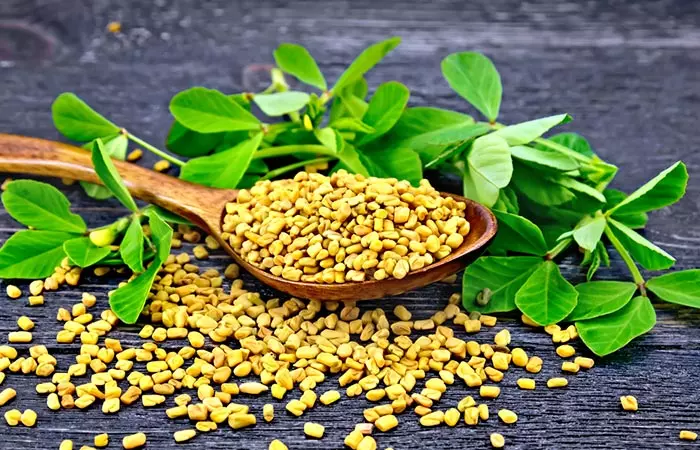
Fenugreek seeds possess analgesic and anti-inflammatory properties (15). They also exhibit neuroprotective effects (16). These properties and effects may help reduce sciatica pain.
You Will Need
- 1 tablespoon of fenugreek powder
- 1 tablespoon of milk
What You Have To Do
- Mix the fenugreek powder and milk.
- Apply it to the affected area.
- Wash it off with warm water after it dries.
How Often You Should Do This
Repeat this 2 times daily.
10. Aloe Vera
Aloe vera juice
contains acemannan, a polysaccharide that has anti-inflammatory properties (17). It also exhibits neuroprotective effects (18). These effects may help in reducing sciatic nerve pain.
You Will Need
- ¼ glass of aloe vera juice
What You Have To Do
- Consume aloe vera juice.
- You may also apply aloe vera gel to the painful areas and massage gently.
How Often You Should Do This
You can do this once daily.
Ananda Sophia Lakshmi Wilson, a second-generation herbalist and blogger, shared some herbal remedies like willow, black birch, wild lettuce, skullcap, St. Johnswort, rue, and mullein root to relieve the pain from sciatica. She states in one of her blog posts, “Personally, I need a higher dose of herbal tinctures when experiencing an acute physical ailment. Doses that would never be listed on a bottle (i).”
These herbal remedies may help manage the symptoms of sciatica to a great extent. In the next section, we have discussed other methods that may help provide relief from sciatica.
Other Methods To Manage Sciatica At Home
Along with trying out home remedies, doing one of the following may help you get relief from the constant pain:
- Do a light workout, yoga, and stretches.
- Take out time for physical therapy and chiropractic care.
- Maintain the right posture to ensure that you don’t strain your back.
- Try over-the-counter medication like mild painkillers that can provide instant relief. However, make sure you consult your doctor.
- Invest in weekly massage therapy or acupuncture to relieve the pain.
- You can try pain relaxation techniques, including meditation.
- Avoid sitting for a long time and walk around at regular intervals.
If you don’t experience any pain relief after employing these self-care techniques, visit your doctor.
When To See A Doctor
You must visit your doctor if the pain persists longer than a week or becomes increasingly unbearable. If you experience sudden pain in your lower back, and if there is numbness in your legs, you must seek immediate medical help. Additionally, if the pain continues to persist after a week of at-home treatment or if it is accompanied by other symptoms like fever, urinary problems, or severe leg weakness, it is best to see a doctor. Serious problems can be avoided with early intervention.
Your doctor may prescribe certain treatments to improve your condition. Scroll down to learn what they are.
Sciatica Treatment Options
Sciatica often requires professional treatment beyond home remedies (19):
1. Physiotherapy: Tailored exercises and stretches that relieve sciatic pain by strengthening the muscles and improving flexibility. Incorporating specific sciatica exercises into your routine can be particularly effective in reducing discomfort and preventing future flare-ups.
2. Medications: Nonsteroidal anti-inflammatory drugs (NSAIDs), muscle relaxants, and in severe cases, prescription painkillers help alleviate pain and inflammation.
3. Steroid Injections: Corticosteroids injected directly into the affected area help reduce inflammation, providing relief.
4. Chiropractic Care: Spinal adjustments and manipulations by chiropractors may relieve nerve compression..
5. Acupuncture: Traditional Chinese acupuncture may help manage pain by stimulating specific points, releasing natural painkillers in the body.
6. Surgery: Surgical interventions like discectomy or laminectomy may be necessary to alleviate pressure on the nerve in severe cases.
7. Physical Modalities: Heat therapy, ultrasound, and electrical stimulation may help provide relief by promoting circulation and reducing muscle spasms.
Infographic: How To Relieve Sciatica Pain With Diet
Besides home remedies for sciatica pain and other pain management options, you can make dietary changes and lifestyle modifications to help alleviate the symptoms of this medical condition.
Check out this infographic to get an idea about the kinds of food to include in your diet and the ones to avoid.
Some thing wrong with infographic shortcode. please verify shortcode syntax
 Trivia
TriviaSciatica or sciatic pain typically begins at the lower back and runs down the legs. It is caused when the sciatic nerve is irritated, the lumbar disc is subjected to excess pressure, or due to underlying conditions like injury, infections, malignant growth, bad posture, or spinal degeneration. Smoking, genetics, vitamin deficiencies, depression, a sedentary lifestyle, or certain occupational practices may trigger sciatic pain. Home remedies for sciatica involve the use of readily available ingredients like garlic, celery, ginger essential oil, valerian root, turmeric, aloe vera, and fenugreek seeds, to name a few. In addition to these, you may benefit from maintaining correct posture and stretching or performing light exercises regularly.
Frequently Asked Questions
Can a chiropractor fix sciatica?
Yes, they may help relieve the pressure on the sciatic nerve and enable you to walk around more easily.
Does sciatica go away on its own?
Sciatica is usually self-limiting, which means that it may go away on its own if you ensure not to strain yourself.
Is a hot bath good for sciatica?
A hot bath might be beneficial for the pain that arises from sciatica. It may relieve pain and increase blood circulation in the concerned area.
How do you stop a sciatica flare-up?
You should not strain your back, pick heavyweights, maintain a good posture, and exercise regularly to make sure that you don’t cause a sciatica flare-up.
Does drinking water help sciatica?
Yes, animal studies suggest that the hydrogen present in water may rescue oxidative stress and the pain experienced due to sciatica (20). However, more studies are warranted to understand this association further.
How long does sciatica take to heal?
With proper treatment and diet, sciatica usually gets better in 4 to 6 weeks. If you continue to experience severe pain after 6 weeks, consult a doctor for alternative treatments.
Illustration: Home Remedies For Sciatica That Reduce Lower Back Pain

Image: Stable Diffusion/StyleCraze Design Team
Seeking relief from sciatica nerve pain? Dive into this enlightening video to explore natural treatment options and valuable insights on how to alleviate discomfort and promote healing.
Personal Experience: Source
StyleCraze's articles are interwoven with authentic personal narratives that provide depth and resonance to our content. Below are the sources of the personal accounts referenced in this article.
i. Sciatica: Top Ten Natural Ways to Ease the (Horrible!) Painhttps://plantjourneys.blogspot.com/2011/07/sciatica-top-ten-natural-ways-to-ease.html
References
Articles on StyleCraze are backed by verified information from peer-reviewed and academic research papers, reputed organizations, research institutions, and medical associations to ensure accuracy and relevance. Read our editorial policy to learn more.
- Arreola, Rodrigo, et al. “Immunomodulation and anti-inflammatory effects of garlic compounds.” Journal of immunology research 2015 (2015).
https://www.ncbi.nlm.nih.gov/pmc/articles/PMC4417560/ - Bayan, Leyla, Peir Hossain Koulivand, and Ali Gorji. “Garlic: a review of potential therapeutic effects.” Avicenna journal of phytomedicine 4.1 (2014): 1.
https://www.ncbi.nlm.nih.gov/pmc/articles/PMC4103721/ - Dehghan, MOrteza, and Farinaz FarahbOD. “The efficacy of thermotherapy and cryotherapy on pain relief in patients with acute low back pain, a clinical trial study.” Journal of clinical and diagnostic research: JCDR 8.9 (2014): LC01.
https://www.ncbi.nlm.nih.gov/pmc/articles/PMC4225921/ - Garra, Gregory, et al. “Heat or cold packs for neck and back strain: a randomized controlled trial of efficacy.” Academic Emergency Medicine 17.5 (2010): 484-489.
https://pubmed.ncbi.nlm.nih.gov/20536800/ - Sritoomma, Netchanok, et al. “The effectiveness of Swedish massage with aromatic ginger oil in treating chronic low back pain in older adults: a randomized controlled trial.” Complementary therapies in medicine 22.1 (2014): 26-33.
https://pubmed.ncbi.nlm.nih.gov/24559813/ - Young, Haw-Yaw, et al. “Analgesic and anti-inflammatory activities of [6]-gingerol.” Journal of ethnopharmacology 96.1-2 (2005): 207-210.
https://pubmed.ncbi.nlm.nih.gov/15588672/ - Lima, Tamires Cardoso, et al. “Analgesic-like activity of essential oil constituents: an update.” International journal of molecular sciences 18.12 (2017): 2392.
https://www.ncbi.nlm.nih.gov/pmc/articles/PMC5751100/ - Sun, Zhenliang, et al. “Chemical composition and anti-inflammatory, cytotoxic and antioxidant activities of essential oil from leaves of Mentha piperita grown in China.” PloS one 9.12 (2014).
https://www.ncbi.nlm.nih.gov/pmc/articles/PMC4262447/ - Xiao, L., et al. “Curcumin alleviates lumbar radiculopathy by reducing neuroinflammation, oxidative stress and nociceptive factors.” European cells & materials 33 (2017): 279.
https://www.ncbi.nlm.nih.gov/pmc/articles/PMC5521990/ - Ma, Junxiong, et al. “Curcumin promotes nerve regeneration and functional recovery after sciatic nerve crush injury in diabetic rats.” Neuroscience letters 610 (2016): 139-143.
https://pubmed.ncbi.nlm.nih.gov/26552010/ - Mauro, G. Letizia, et al. “Vitamin B~ 1~ 2 in low back pain: a randomised, double-blind, placebo-controlled study.” European review for medical and pharmacological sciences 4 (2000): 53-58.
https://pubmed.ncbi.nlm.nih.gov/11558625/ - Lodh, Moushumi, et al. “Assessment of vitamin D status in patients of chronic low back pain of unknown etiology.” Indian Journal of Clinical Biochemistry 30.2 (2015): 174-179.
https://www.ncbi.nlm.nih.gov/pmc/articles/PMC4393394/ - Lewis, David A., Saleh M. Tharib, and G. Bryan A. Veitch. “The anti-inflammatory activity of celery Apium graveolens L.(Fam. Umbelliferae).” International Journal of Crude Drug Research 23.1 (1985): 27-32.
https://www.tandfonline.com/doi/abs/10.3109/13880208509070685 - Zare, Afshin, et al. “Analgesic Effect of Valerian Root and Turnip Extracts.” World journal of plastic surgery 7.3 (2018): 345.
https://www.ncbi.nlm.nih.gov/pmc/articles/PMC6290317/ - Yadav, Umesh CS, and Najma Z. Baquer. “Pharmacological effects of Trigonella foenum-graecum L. in health and disease.” Pharmaceutical biology 52.2 (2014): 243-254.
https://www.tandfonline.com/doi/full/10.3109/13880209.2013.826247 - Kumar, P., et al. “Antidiabetic and neuroprotective effects of Trigonella foenum-graecum seed powder in diabetic rat brain.” Prague Med Rep 113.1 (2012): 33-43.
https://pubmed.ncbi.nlm.nih.gov/22373803// - Kanyadhara, Swetha, et al. “Ethanolic extract of Aloe vera ameliorates sciatic nerve ligation induced neuropathic pain.” Ancient science of life 33.4 (2014): 208.
https://www.ncbi.nlm.nih.gov/pmc/articles/PMC4293747/ - Guven, Mustafa, et al. “The effect of aloe vera on ischemia—Reperfusion injury of sciatic nerve in rats.” Biomedicine & Pharmacotherapy 79 (2016): 201-207.
https://pubmed.ncbi.nlm.nih.gov/27044829// - Sciatica, StatPearls, US National Library Of Medicine (2025)
https://www.ncbi.nlm.nih.gov/books/NBK507908/ - Tang S.J, “Molecular Hydrogen Attenuates Neuropathic Pain in Mice” US national Library of Medicine (2014) 9(6)
https://www.ncbi.nlm.nih.gov/pmc/articles/PMC4062523/
Read full bio of Dr. Zeel Gandhi
Read full bio of Sucharita Mishra
Read full bio of Arshiya Syeda
Read full bio of Dipti Sharma












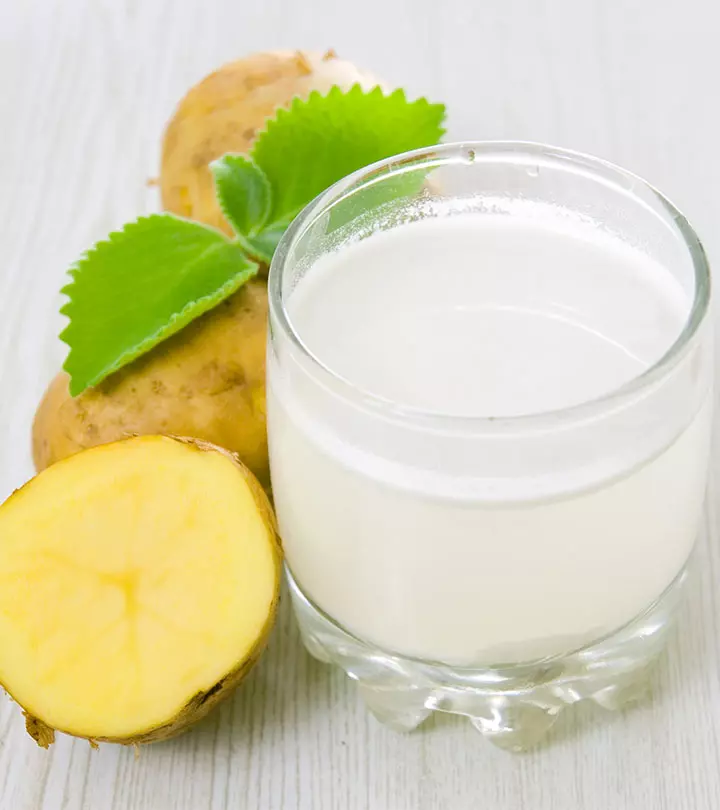













Community Experiences
Join the conversation and become a part of our empowering community! Share your stories, experiences, and insights to connect with other beauty, lifestyle, and health enthusiasts.